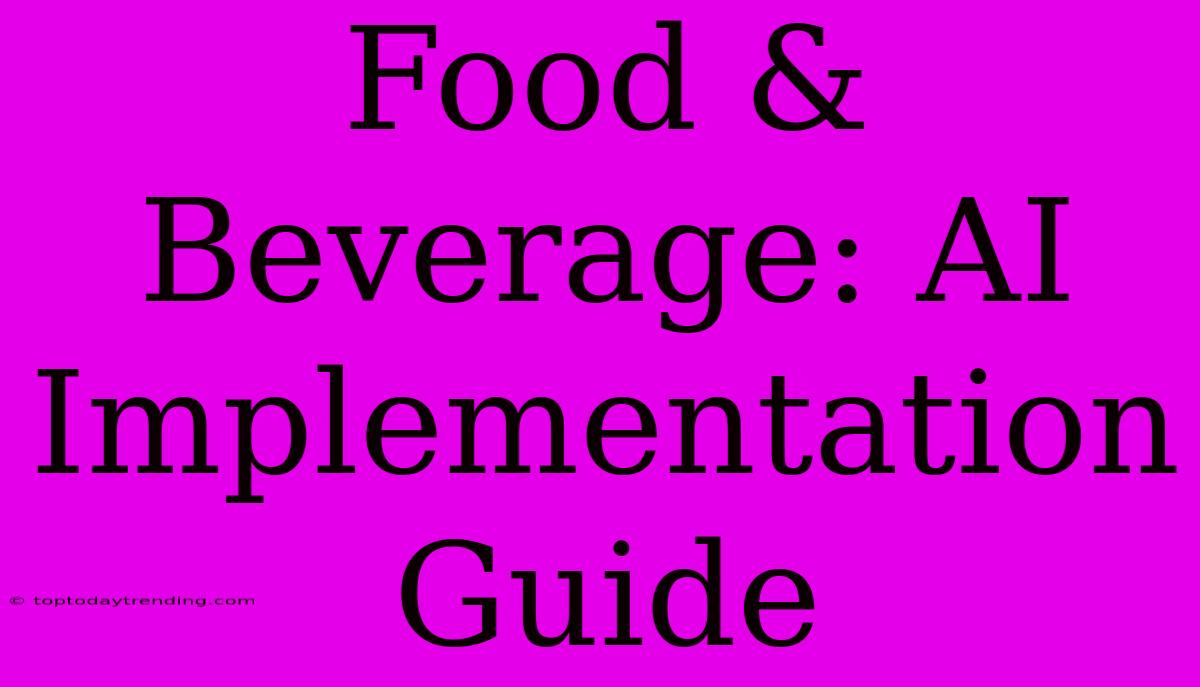Food & Beverage: AI Implementation Guide
The food and beverage (F&B) industry is ripe for disruption. From optimizing supply chains to personalizing customer experiences, artificial intelligence (AI) is emerging as a powerful tool for driving efficiency, innovation, and growth. This guide will delve into the potential of AI in the F&B sector, exploring key applications, benefits, and implementation strategies.
Understanding the Power of AI in F&B
AI encompasses a range of technologies, including machine learning, deep learning, and natural language processing. These technologies enable machines to learn from data, make predictions, and automate tasks, unlocking unprecedented opportunities for the F&B industry.
Key AI Applications in F&B
1. Supply Chain Optimization
- Predictive Analytics: AI can analyze historical data and external factors to forecast demand, predict supply chain disruptions, and optimize inventory levels, reducing waste and ensuring timely deliveries.
- Route Optimization: AI-powered algorithms can plan optimal delivery routes, minimizing transportation costs and maximizing delivery efficiency.
- Quality Control: AI-enabled image recognition systems can detect defects in raw materials or finished products, ensuring product quality and safety throughout the supply chain.
2. Personalized Customer Experiences
- Recommendation Engines: AI can analyze customer data to recommend personalized products and promotions, enhancing customer engagement and loyalty.
- Chatbots: AI-powered chatbots can provide 24/7 customer support, answer questions, and resolve issues, improving customer satisfaction.
- Personalized Nutrition Plans: AI can create personalized nutrition plans based on individual dietary needs and preferences, offering a customized and healthy food experience.
3. Enhanced Food Safety & Quality
- Food Safety Monitoring: AI-driven sensors and data analytics can track food temperature, humidity, and other critical parameters, alerting stakeholders to potential safety issues in real time.
- Fraud Detection: AI can analyze data to identify fraudulent activities in the food supply chain, ensuring authenticity and safety of food products.
- Product Development & Innovation: AI can assist in developing new recipes and food products, optimizing ingredient combinations and flavor profiles for enhanced consumer appeal.
Benefits of AI Implementation in F&B
- Increased Efficiency & Productivity: Automation of repetitive tasks and optimized processes lead to significant gains in efficiency and productivity.
- Enhanced Customer Satisfaction: Personalized experiences, improved customer service, and access to tailored solutions increase customer satisfaction and loyalty.
- Reduced Costs & Waste: AI-driven optimization of supply chain operations and inventory management minimizes waste and lowers overall operational costs.
- Improved Food Safety & Quality: Real-time monitoring and predictive analytics enhance food safety measures and ensure consistent product quality.
- Data-Driven Decision-Making: AI provides insights and data-driven recommendations, enabling more informed and strategic decision-making.
Implementing AI in your F&B Business
- Identify Key Areas of Improvement: Determine the areas where AI can have the greatest impact on your business, focusing on specific challenges and opportunities.
- Choose the Right AI Solutions: Select AI solutions that best align with your business needs, considering factors like budget, data availability, and integration capabilities.
- Develop a Data Strategy: Ensure access to clean, reliable, and relevant data for AI model training and optimization.
- Invest in Talent & Training: Train your team on AI concepts, tools, and applications to ensure successful implementation and adoption.
- Start Small & Scale Gradually: Begin with a pilot project in a specific area, gathering valuable insights and experience before scaling AI implementation across your business.
- Monitor & Evaluate Performance: Continuously monitor the performance of AI solutions, refine algorithms, and adapt to changing business needs.
Conclusion
AI presents a transformative opportunity for the food and beverage industry, offering a path to increased efficiency, enhanced customer experiences, and improved food safety. By embracing AI, F&B companies can unlock new possibilities, gain a competitive edge, and thrive in the ever-evolving market.

